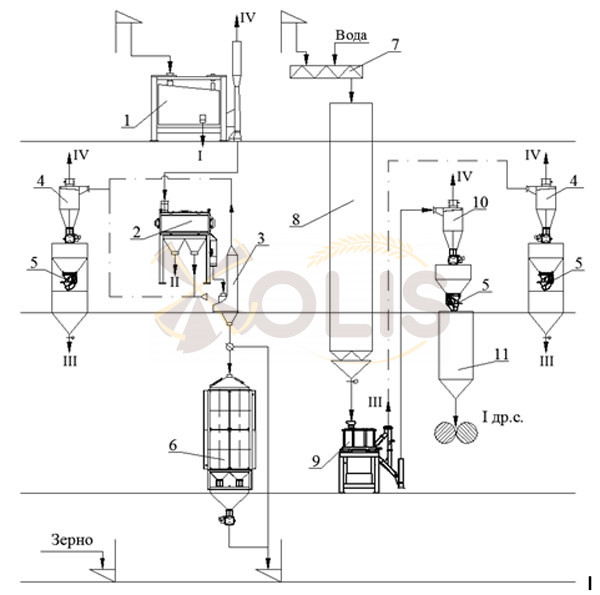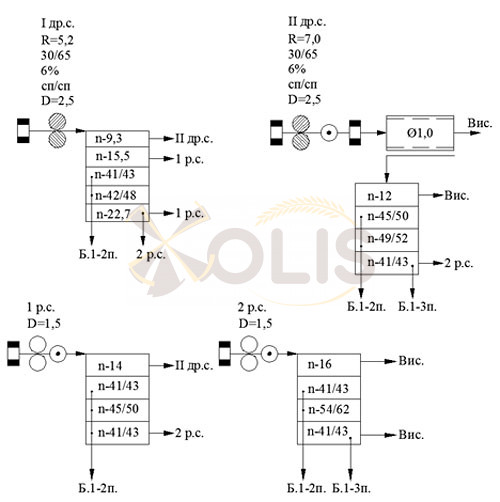Vereshchinsky A.P., Ph.D., General Director of OLIS LLC
Ilchuk V.B., Ph.D., Director of the Scientific and Technical Center “Design and Technologies of the Agro-Industrial Complex” NICH NUH
As you know, Ukraine inherited from the Soviet Union a powerful flour-milling industry, which annually processed about 7 million tons of wheat grain. It was based on flour mills with a capacity of 250 and 500 tons/day, which are still in operation and implement developed processing structures. In addition, in the last twenty years, a significant number of flour mills of smaller capacity have been built, implementing reduced and short processing structures. Currently, about 30% of flour is produced at the new facilities. Taking into account the fact that the volume of flour production in Ukraine has halved over the past decades, its production capacity is now three times higher than the needs. However, most entrepreneurs assess flour production as a stable and very profitable component of agribusiness. Despite the large excess of production capacity, they are creating new and reconstructing outdated production facilities, introducing technologies and equipment that provide competitive advantages.
In February-March of this year. In the Nikolaev region, a new flour mill with a capacity of 30 tons/day of high-quality grinding of wheat into baking flour was put into permanent operation.The basis of the innovative technology that was introduced was the reduction of the grinding structure by intensifying processing processes using grain peeling operations.
Technological schemes of the preparatory and grinding departments (Fig. 1, 2) were developed with the maximum possible minimization of costs for creating production and ensuring competitive performance indicators. The use of a grain processing operation in a wallpaper-husking machine of the MAO type (Fig. 1) ensures cleaning of the surface of the grain and removal of some of the weeds and grain impurities. In addition, this treatment causes a change in the hygroscopic properties of the grain, allowing for effective cold conditioning in one step for most milling batches of wheat while reducing the duration of cooling by 25%. Peeling of grain after WTO with an index value of 6-8% ensures its further purification from impurities, reducing the specific content of shells and strength. The quantitative and qualitative indicators of grain products formed during the grinding of hulled grains determine a corresponding change in the structure of the grinding stage, which is also characterized by a significant reduction.
Fig.1. Schematic flow diagram of the stage of preparing grain for grinding:
1—sieve-air separator;
2 – MAO type wallpaper peeling machine;
3 – air separator;
4 – cyclone;
5 – scales;
6 – grain heater type PZ;
7 – screw conveyor;
8 – hopper for grain storage;
9 – peeling and grinding machine of the “Cascade” design;
10 – cyclone-unloader;
11 – bunker;
I – discharge of the sorting screen and passage of the underseeding sieves of the separator;
II – wallpaper dust;
III – separated shells;
IV – air to aspiration and pneumatic transport systems.
Grain grinding (Fig. 2) is carried out using low grinding modes, provided on the I torn system by previous peeling, on grinding systems – by the additional differentiated action of the dismembrator, and grinding of the shells is carried out according to the structure : roller machine – dismembrator – grinding machine.
Fig.2. Schematic flow diagram of the grain grinding stage
Analysis of the quantitative-qualitative balance of grinding (Table 1) and possible options for the formation of flour varieties (Table 2) once again confirmed the technical possibility of effectively carrying out both multi-grade grinding and single-grade grinding grinding with the yield of premium flour, without the use of processes for enriching intermediate products.
Table 1. Quantitative-qualitative balance of a flour mill (yield, % / ash content, %)
| System | Load, % | I dr.s. | II dr.s. | 1 RUR | 2 rs. | High grade flour | First grade flour | Second grade flour | Bran |
| Cascade | 100 | 93.2 | 6.8 | ||||||
| I etc. | 93.2 | 29.3 | 45.7 | 7.0 | 11.2 | ||||
| II dr.s. | 31,62,85 | 3.7 | 9.4 | 1.0 | 17.5 | ||||
| 1 rub. | 45.7 | 2,3 | 8.4 | 35.0 | |||||
| 2 р.с. | 19.1 | 7.0 | 9.1 | 0.7 | 2,3 | ||||
| Total | 53.2 | 18.5 | 1.7 | 26.6 |
Table 2. Formation of flour varieties
| Flour type | Single-grade grinding | Double-grade grinding | Three-grade grinding | |||
| output, % | whiteness, unit R3-BPL | output, % | whiteness, unit R3-BPL | output, % | whiteness, unit R3-BPL | |
| highest, % | 70.0 | 57 | 58.0 | 58 | 53.2 | 59 |
| first, % | 13.5 | 43 | 18.5 | 45 | ||
| second, % | 1.7 | 21 | ||||
| total, % | 70.0 | 71.5 | 73.4 | |||
The production building of the production in question is located in a building with an area of 200 m2 and a height of 8.5 m. About 75 kWh of electricity and 4750 m3 of air are spent on processing 1 ton of grain. The indicated energy and air consumption are respectively 1.6 and 1.5 times less than in flour mills with a developed structure, and 1.08 and 1.3 times less than in factories with a short structure built using traditional technology. The flour mill operates automatically and is serviced by an operator and a worker.
The considered production is a newly built low-capacity production. At the same time, this is one of 24 flour mills with a capacity of up to 200 tons/day, where the efficiency of varietal baking wheat grinding is ensured by reducing the processing structure using grain peeling. These implementations have been carried out since 2004 at enterprises in Ukraine and Russia. A significant part of them are reconstructions of existing production facilities, incl. production of significant productivity with developed structures. Such production uses a lot of equipment and production space, and is energy and resource intensive. They provide the highest possible degree of use of grain for flour production, but this advantage is not decisive in modern economic conditions. Increasing the flour yield due to flour formed by any grain grinding technology with flour production of more than 73-74% is an economically unfeasible measure. It is obvious that such production requires improvement in the direction of saving energy, resources, rational use of grain, production space and equipment. Owners and managers of such industries are increasingly convinced of this, as can be seen from the number of their requests.
Currently, one of the industrial flour mills is being reconstructed with a developed structure implemented on complete equipment, where an additional goal to increase processing efficiency is to increase the plant’s productivity from 270 to 350 tons/day .The assigned tasks are solved using developed innovative methods for reducing structures that are in our arsenal of proven solutions. One of these methods is the introduction of preparing grain for grinding by fractionation, followed by rolling the coarse and peeling its fine fraction.
Grain husking is the initial process of sequential release of the endosperm from the shells, best corresponding to the essence of varietal grinding. Therefore, the use of this technological process in flour production has been the subject of increased attention of scientists and practitioners for over a century. However, the complexity of the nature of grain required a lot of research work and significant implementation efforts to obtain practical results in this direction. In recent years, the Japanese company SATAKE has been actively declaring flour production technology using peeling. Bühler also claims to use peeling processes in the production of pasta flour. There are known steps in the same direction by other global manufacturers. Ukraine also has its own innovative flour production technologies that use peeling, implemented using original equipment, tested and working efficiently.
published in the publication
“Grain storage and processing”
scientific and practical journal
5 (170) May 2013































